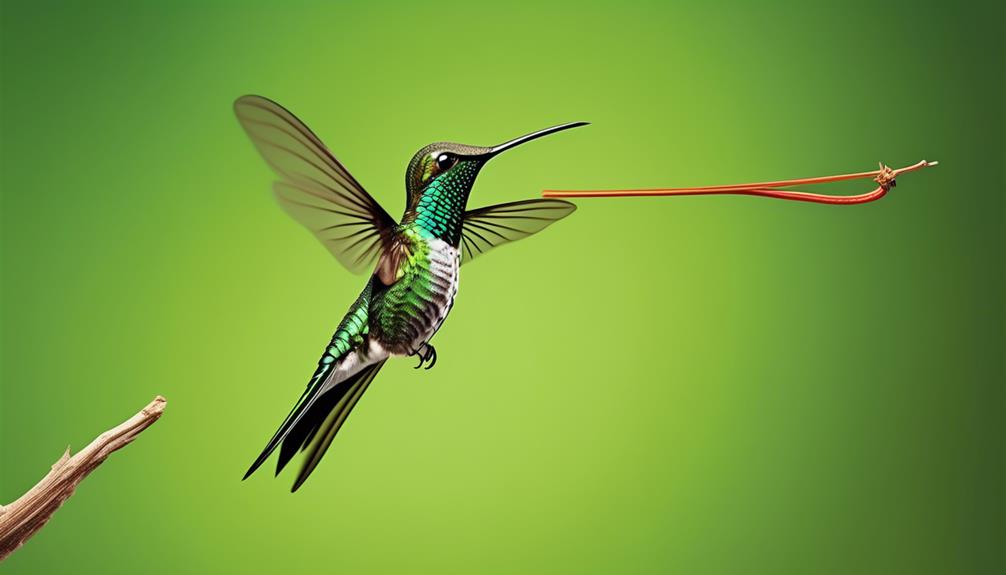As you walk along a secluded forest path, you can’t help but notice a delicate creature gracefully perched on a leaf. Its slender body blends seamlessly with the surrounding foliage, making it nearly invisible to the untrained eye.
Intrigued by its mysterious presence, you find yourself wondering what other small and long skinny animals exist in the vast tapestry of nature. From insects that mimic twigs to fish that slice through the water with razor-sharp precision, the animal kingdom holds a myriad of fascinating examples.
So, prepare to be captivated as we unravel the secrets of these enchanting creatures and uncover the extraordinary tales they have to share.
Skinny Insects
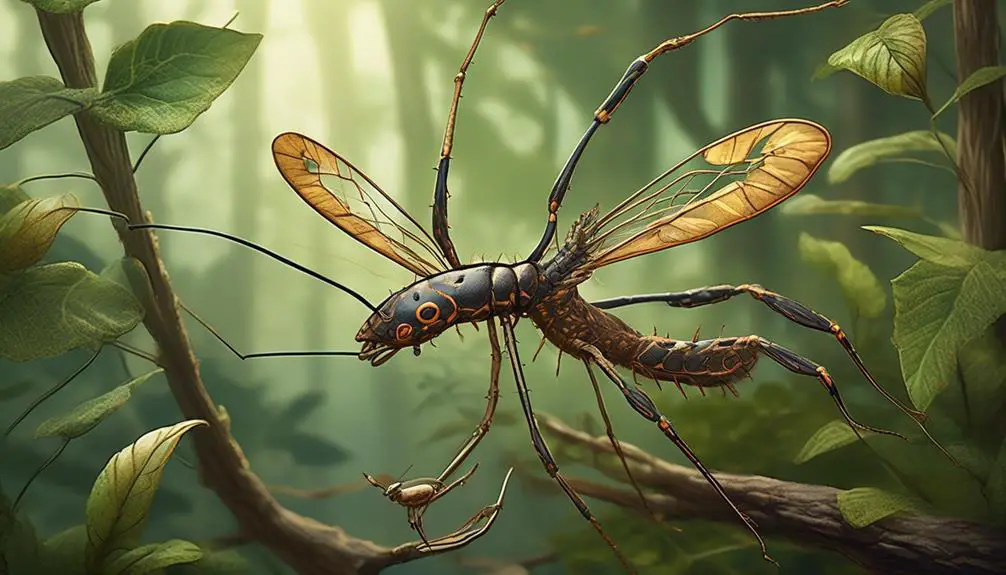
Skinny insects, such as the stick bug (Phasmatodea) and the mantis (Mantodea), possess long and slender bodies that allow them to blend seamlessly into their surroundings. This adaptation serves as a defense mechanism against predators and increases their chances of survival.
The stick bug, also known as the walking stick, showcases an impressive camouflage ability. Its body resembles a small branch, complete with tiny spines and irregular color patterns, making it virtually indistinguishable from its arboreal habitat. This insect is predominantly herbivorous, feeding on leaves and vegetation.
The mantis, on the other hand, is a formidable predator. Its elongated body, resembling a twig, helps it ambush unsuspecting prey. With its sharp forelegs and keen eyesight, the mantis snatches insects with lightning speed.
These slender insects can be found worldwide, except for Antarctica, thriving in various climates and ecosystems. Their unique adaptations for camouflage and hunting make them fascinating creatures to study in the realm of entomology.
Stick Bug
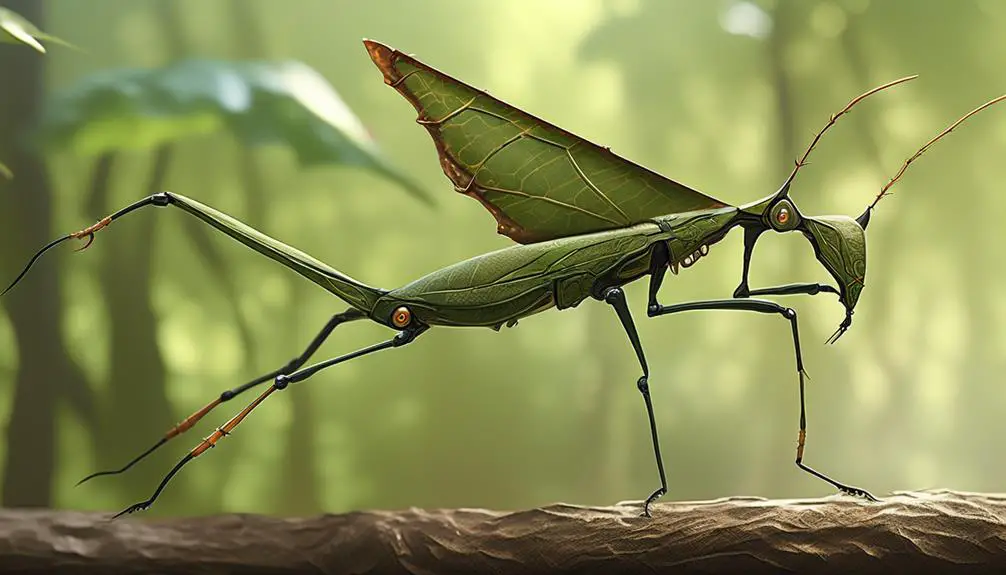
The Stick Bug, scientifically known as Phasmatodea, exhibits remarkable adaptations for camouflage. With its long and slender appearance, it’s able to blend in seamlessly with branches, making it difficult to detect by predators.
This insect has a global distribution, being found everywhere except for Antarctica, and it thrives in various habitats, from temperate to tropical areas.
Adaptations for Camouflage
With its long and slender body, the stick bug possesses remarkable adaptations for camouflage that allow it to blend seamlessly with its surroundings. The stick bug’s primary defense mechanism is its ability to mimic the appearance of a twig or branch. Its body shape and coloration closely resemble the texture and color of the plants it inhabits. This remarkable camouflage allows the stick bug to remain undetected by predators, as it becomes virtually invisible among the foliage.
Additionally, the stick bug has the ability to remain motionless for extended periods, further enhancing its camouflage. It can contort its body to resemble a broken or dead branch, making it even more difficult for predators to spot. These adaptations for camouflage make the stick bug a master of disguise in the natural world.
Global Distribution and Habitats
As we continue our exploration of the stick bug, let’s now turn our attention to its global distribution and the diverse habitats in which it can be found.
Stick bugs, scientifically known as Phasmatodea, are widely distributed around the world, with the exception of Antarctica. These fascinating insects can be found in a variety of habitats, ranging from tropical rainforests to temperate forests and even suburban gardens.
They’re particularly abundant in regions such as Southeast Asia, Central America, and Australia. Stick bugs are well-adapted to their environments, as their slender bodies and ability to camouflage among branches allow them to blend seamlessly with their surroundings.
This enables them to avoid predators and ensures their survival in their respective habitats.
Mantis
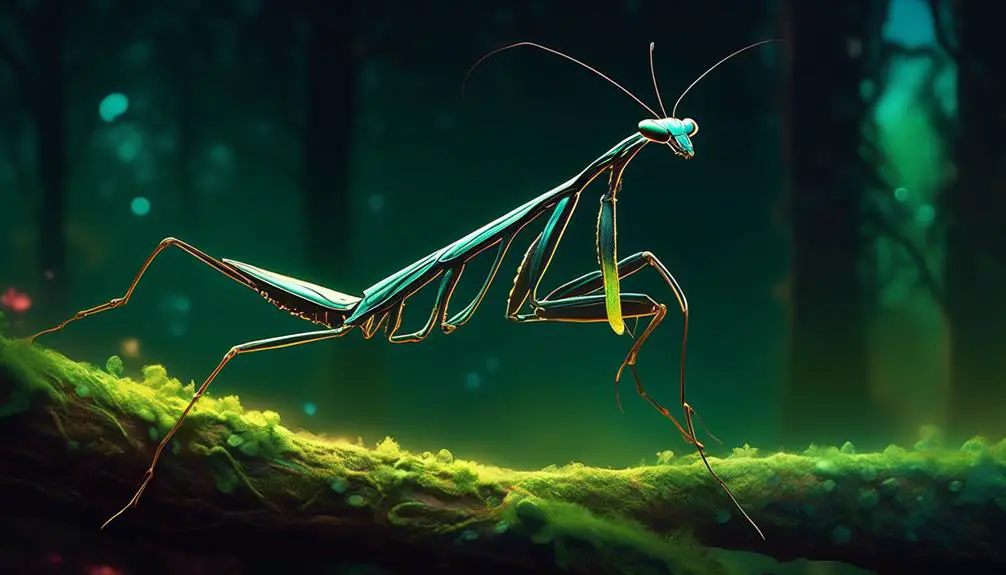
Now let’s explore the fascinating world of the Mantis.
As you delve into the life cycle of the Mantis, you’ll discover the intricate stages it goes through, from egg to adult.
You’ll also learn about the Mantis’s hunting techniques, which are incredibly efficient and often involve stealthily ambushing its prey.
Additionally, we’ll discuss the Mantis’s remarkable camouflage abilities, allowing it to blend seamlessly with its surroundings and remain virtually invisible to unsuspecting victims.
Mantis Life Cycle
The life cycle of the Mantis, a carnivorous insect belonging to the Mantodea order, is a fascinating process that encompasses several distinct stages.
It begins with the female mantis laying eggs, which are encased in a protective foam-like substance called an ootheca. These eggs take several weeks to hatch, and once they do, the young mantises, known as nymphs, emerge.
Nymphs resemble miniature versions of adult mantises and undergo a series of molts as they grow. Each molt allows the nymph to shed its exoskeleton and develop a larger one.
As the nymphs continue to grow, they eventually reach adulthood. The final stage of the mantis life cycle is the adult phase, where the insects are fully developed and capable of reproducing.
During this stage, the mantises engage in courtship rituals and mating, starting the life cycle anew.
Mantis Hunting Techniques
Continuing our exploration of the fascinating life cycle of the Mantis, let’s now delve into the captivating world of Mantis hunting techniques.
The Mantis is a masterful predator, employing various strategies to capture its prey. One common technique is known as ambush hunting, where the Mantis remains motionless, blending seamlessly with its surroundings, and waits for an unsuspecting insect to come within striking distance. With lightning-fast reflexes, the Mantis quickly extends its forelegs, equipped with sharp spines, to snatch its prey.
Another technique utilized by the Mantis is stalking. In this method, the Mantis stealthily creeps towards its target, using its long, slender body to its advantage, while keeping a cautious distance to avoid detection. Once within range, the Mantis pounces, immobilizing its prey with a swift and powerful strike.
These hunting techniques highlight the Mantis’s remarkable adaptability and predatory prowess in the natural world.
Mantis Camouflage Abilities
Mantis exhibits impressive camouflage abilities that allow it to seamlessly blend into its surroundings, making it virtually invisible to unsuspecting prey. This remarkable ability is due to the mantis’ specialized body structure and coloration. Here is a table highlighting some of the key features that contribute to the mantis’ camouflage abilities:
| Camouflage Feature | Description |
|---|---|
| Cryptic Coloration | Mantis has a variety of color patterns that mimic its environment, such as shades of green or brown, enabling it to blend in perfectly. |
| Mimicking Movements | Mantis can sway or sway back and forth like a leaf or a twig, imitating the movements of its surroundings. |
| Camouflaged Body Shape | Mantis has a long and slender body, often resembling a stick or a leaf, allowing it to hide among plants or branches. |
| Mimicking Background | Mantis can change its color to match its background, adapting to different environments and becoming virtually invisible. |
These camouflage abilities enable the mantis to become a stealthy predator, patiently waiting for its prey to come within striking distance. By blending seamlessly into its surroundings, the mantis increases its chances of a successful hunt while remaining hidden from potential threats.
Praying Mantis
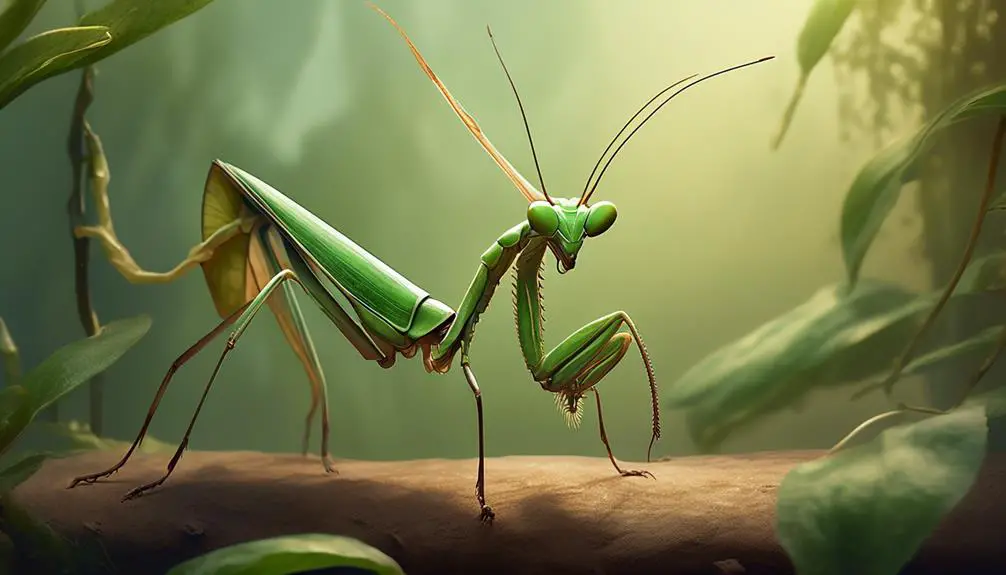
With its lighter green color and folded front legs, the praying mantis is a distinct and fascinating insect. The scientific name for the praying mantis is Mantodea.
As a carnivore, its diet consists of insects. The praying mantis has a unique appearance, with a long and slim body resembling a stick. It’s prevalent on every continent except Antarctica, thriving in temperate and tropical climates.
The praying mantis is known for its exceptional hunting abilities. It uses its front legs to capture and hold its prey while it devours it. The folded front legs of the praying mantis give it a praying-like appearance, which is where its name originates from.
This insect has excellent camouflage skills, blending in with its surroundings to ambush unsuspecting prey. Its slender physique and green coloration help it remain concealed from predators.
The praying mantis is truly a fascinating creature with its distinct appearance and hunting techniques.
Stick Insect
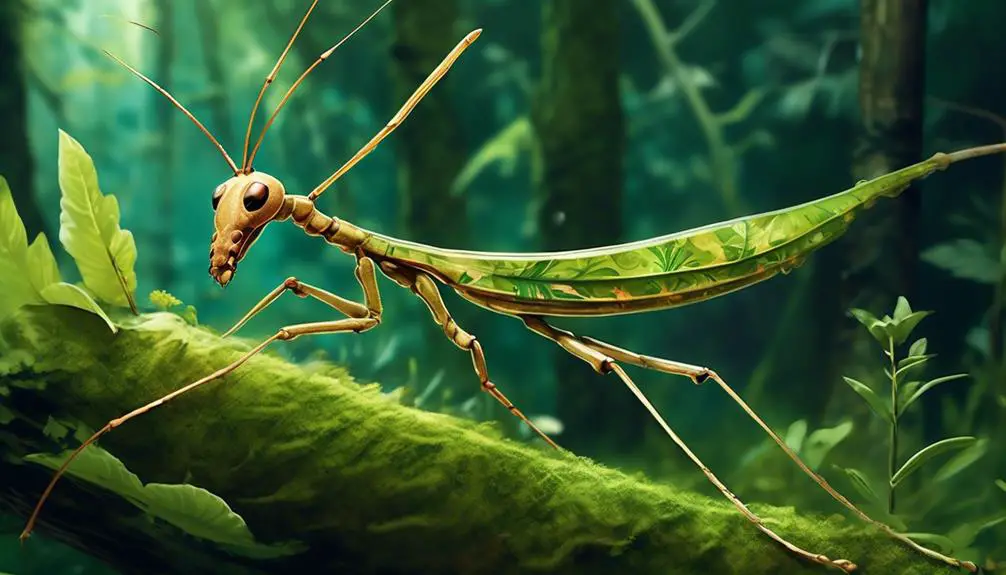
The Stick Insect, also known as Phasmatodea, is an intriguing insect species that shares similarities with the praying mantis in terms of its diet and appearance. These insects are herbivores, feeding on plant material such as leaves and stems. They’ve a long and slender body, resembling a small branch, which allows them to blend in seamlessly with their environment. This camouflage serves as a defense mechanism against predators, making it difficult for them to be detected.
Stick insects can be found in various habitats worldwide, except for Antarctica. They thrive in temperate and tropical areas, where they can find an abundance of vegetation to feed on. These insects have adapted to their surroundings by evolving a slender physique that aids in their survival.
One notable characteristic of stick insects is their ability to regenerate lost limbs. If a predator manages to capture a stick insect, it can detach a leg as a means of escape. The leg will continue to twitch, distracting the predator while the stick insect makes its getaway. Over time, the lost leg will regenerate, allowing the insect to continue its life.
Stick-Bug
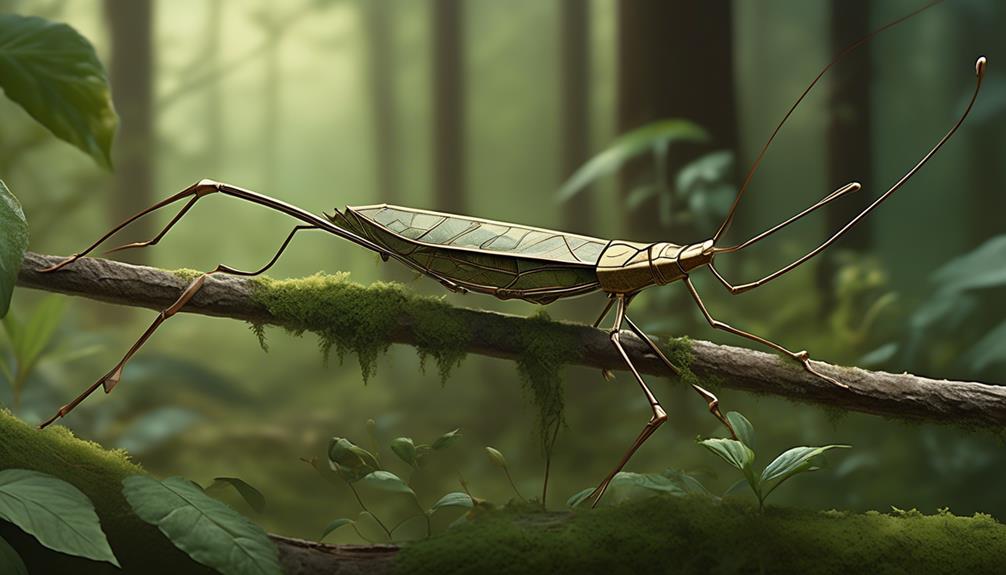
The Stick-Bug, scientifically known as Phasmatodea, possesses remarkable adaptations for camouflage. Its long and slender body allows it to blend seamlessly with branches, making it difficult for predators to spot. As a herbivore, the Stick-Bug relies on its ability to hide in plain sight while feeding on vegetation.
This insect exhibits a global distribution, being found in various habitats worldwide, with the exception of Antarctica.
Adaptations for Camouflage
The stick-bug, scientifically known as Phasmatodea, possesses remarkable adaptations for camouflage that allow it to seamlessly blend into its surroundings.
One of its most striking features is its long and slender body, resembling a small branch or twig. This physical characteristic enables the stick-bug to mimic its environment, making it difficult for predators to detect.
Additionally, stick-bugs have the ability to change their color to match that of their surroundings, further enhancing their camouflage. This adaptation is achieved through the manipulation of pigments in their exoskeleton. By adjusting the concentration and distribution of these pigments, stick-bugs can blend in seamlessly with the foliage or bark they’re clinging to.
Such adaptations for camouflage are crucial for the stick-bug’s survival, allowing it to evade predators and go unnoticed in its habitat.
Herbivorous Diet
With its herbivorous diet, the stick-bug, scientifically known as Phasmatodea, relies on consuming plant matter to fulfill its nutritional needs. These slender insects have adapted to their environment by developing a specialized diet that consists solely of vegetation. The table below provides a visual representation of other skinny animals with herbivorous diets.
| Animal | Scientific Name | Diet |
|---|---|---|
| Stick-Bug | Phasmatodea | Herbivore |
| Koala | Phascolarctos | Herbivore |
| Iguana | Iguanidae | Herbivore |
The stick-bug’s ability to blend in with its surroundings allows it to safely consume leaves and other plant materials without being detected by predators. By relying on a herbivorous diet, the stick-bug has adapted to its environment and thrives in various habitats worldwide.
Global Distribution
The stick-bug, a slender insect known scientifically as Phasmatodea, has a global distribution that spans various habitats worldwide. These fascinating creatures can be found in diverse environments such as forests, grasslands, and tropical rainforests. They’re particularly abundant in regions with a warm and humid climate, where they thrive due to the abundance of vegetation for their herbivorous diet.
Stick-bugs can be found on every continent except for Antarctica, showcasing their ability to adapt and survive in different conditions. Their remarkable camouflage skills and elongated bodies allow them to blend seamlessly with their surroundings, making them difficult to detect by predators. Despite their delicate appearance, stick-bugs have managed to colonize a wide range of habitats, further highlighting their global distribution.
Skinny Fish

Slim and streamlined, skinny fish possess a slender physique that allows them to effortlessly glide through their freshwater habitats.
One example of a skinny fish is the Pike (Esox Lucius). With its sharp snout and razor-edged teeth, the Pike has a streamlined body that enables it to swiftly maneuver through the water. This carnivorous fish can be found in freshwater bodies in Northern America, Western Europe, Siberia, and Asia.
Another skinny fish is the Slim Fish, which shares a similar appearance to the Pike. It also has a streamlined body, but with a unique grey-green hue and patterns that help it blend into its surroundings in shallow waters.
The Slender Fish, Thin Fish, and Esox are other examples of skinny fish that exhibit the same streamlined body structure and coloration. These fish can be found in various freshwater habitats across different regions.
With their slender physiques, they’re perfectly adapted to their aquatic environments, allowing them to swiftly navigate through the water in search of prey.
Pike
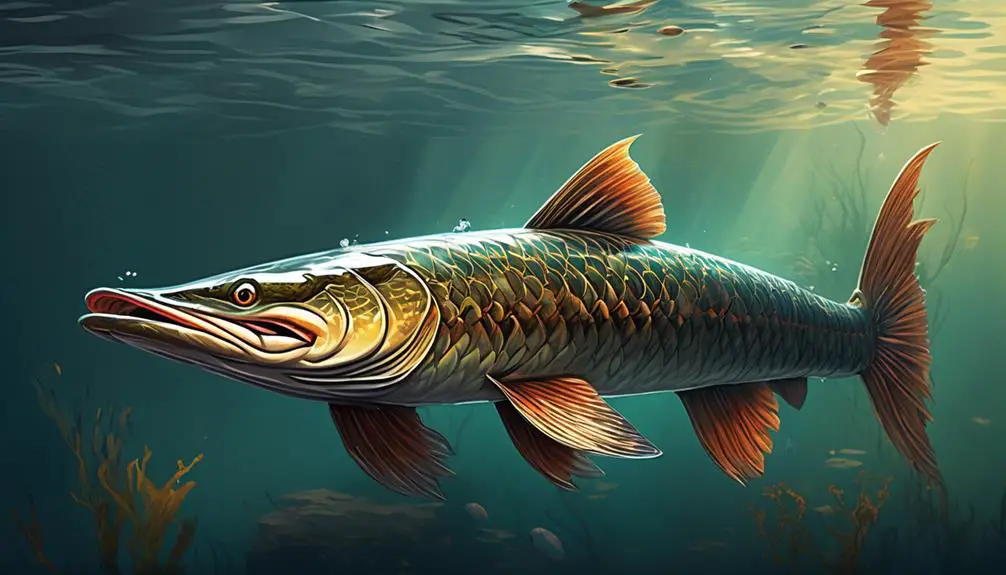
The pike, scientifically known as Esox Lucius, is a carnivorous fish with a streamlined body, a sharp snout, and razor-edged teeth. It’s primarily found in freshwater bodies in Northern America, Western Europe, Siberia, and Asia.
The pike’s adaptations for hunting include its streamlined body, which allows it to swiftly move through the water, and its sharp teeth, which enable it to catch and devour its prey with ease.
Adaptations for Hunting
With its streamlined body, razor-edged teeth, and sharp snout, the pike possesses a remarkable set of adaptations for hunting.
The pike’s sleek and elongated body allows it to effortlessly cut through the water, enabling quick and agile movement to pursue its prey.
Its teeth, specifically designed for grasping and impaling, are sharp and pointed, perfect for securing a firm hold on its victims.
The pike’s sharp snout aids in accurately detecting and targeting its prey, honing in on vibrations and disturbances in the water.
These adaptations work together to make the pike an efficient and deadly predator, ensuring its success in capturing its meals.
Distribution and Habitat
The pike, a freshwater fish known for its streamlined body and predatory prowess, can be found in diverse habitats across Northern America, Western Europe, Siberia, and Asia. It is a highly adaptable species, capable of thriving in various aquatic environments such as lakes, rivers, and ponds. Pike are particularly abundant in regions with abundant vegetation, as they use the cover provided by aquatic plants to ambush their prey. They are also known to inhabit areas with structure, such as submerged logs and rocky areas, which provide additional hiding places and hunting opportunities. The following table provides a summary of the distribution and habitat preferences of the pike:
| Location | Habitat |
|---|---|
| Northern America | Lakes, rivers, ponds, areas with vegetation and structure |
| Western Europe | Lakes, rivers, ponds, areas with vegetation and structure |
| Siberia | Lakes, rivers, ponds, areas with vegetation and structure |
| Asia | Lakes, rivers, ponds, areas with vegetation and structure |
Slim Fish

Slim fish, also known as slender fish, are a group of carnivorous fish species that possess a streamlined body, a grey-green hue, and unique patterns. These fish have a sleek and elongated physique, allowing them to effortlessly glide through the water. With their streamlined body shape, they’re well adapted for swift and agile movements, making them efficient hunters in their aquatic environment.
One example of a slim fish is the pike, scientifically known as Esox Lucius. This fish species has a slender body with a sharp snout and razor-edged teeth. Its grey-green coloration and unique patterns help it blend into its surroundings, making it an effective ambush predator. Pikes are primarily found in freshwater bodies in Northern America, Western Europe, Siberia, and Asia.
Another example of a slim fish is the slender fish, which shares similar characteristics to the pike. It also has a streamlined body, a grey-green hue, and unique patterns. Slender fish are often camouflaged in shallow waters, allowing them to surprise their prey. Like the pike, they’re carnivorous and rely on their agility and speed to catch smaller fish.
Slender Fish
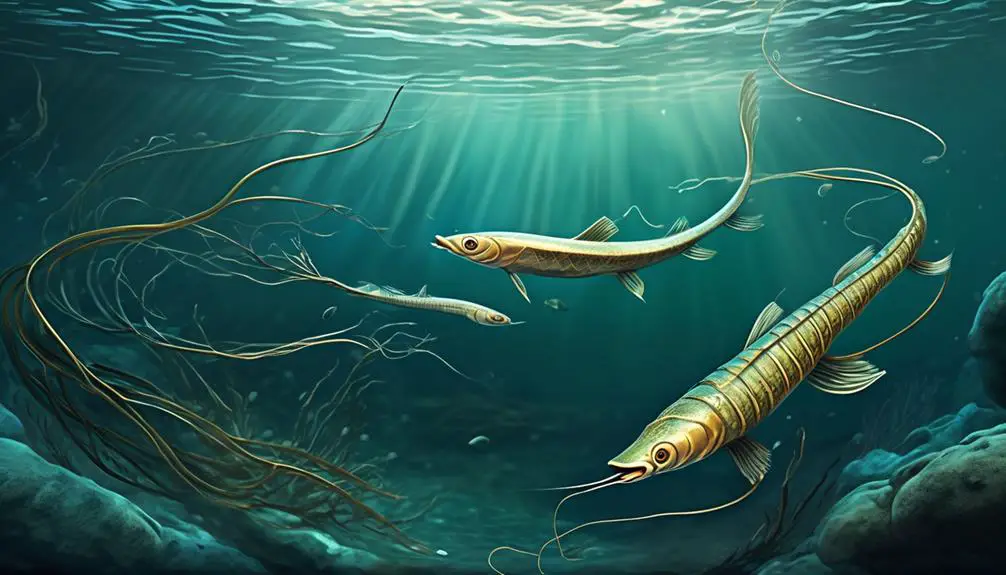
As we turn our attention to the subtopic of slender fish, we continue our exploration of these carnivorous fish species that possess a streamlined body, a grey-green hue, and unique patterns.
Slender fish, scientifically known as Esox Lucius, are a remarkable group of freshwater fish found in Northern America, Western Europe, Siberia, and Asia. These fish are known for their elongated bodies, which enable them to swiftly navigate through water. With their sleek physique and slender shape, they’re perfectly adapted for hunting and capturing prey.
The slender fish have a striking appearance, characterized by their grey-green hue and distinctive patterns. These patterns, often consisting of dark vertical bars or spots, aid in camouflaging the fish among aquatic vegetation and shadows. This enables them to ambush their unsuspecting prey with precision and speed. Their razor-edged teeth further enhance their predatory abilities, allowing them to tear through the flesh of smaller fish and crustaceans.
In terms of habitat, slender fish are primarily found in freshwater bodies such as lakes, rivers, and ponds. They prefer shallow waters, where they can blend in with the surroundings and remain hidden from potential predators. These fish are highly adaptable and can thrive in a variety of environments, from cold northern regions to temperate zones.
Thin Fish

Thin fish, known scientifically as Esox Lucius, are carnivorous freshwater fish with a streamlined body, grey-green hue, and unique patterns. These fish have a slender physique, allowing them to move swiftly through the water. Their bodies are designed for speed and agility, with a long, torpedo-like shape that minimizes drag. The thin fish’s sharp snout and razor-edged teeth are perfectly adapted for capturing and consuming their prey.
In terms of appearance, thin fish have a distinct grey-green coloration that helps them blend in with their surroundings. They often display unique patterns, such as dark blotches or stripes, which further aid in camouflage. This allows them to remain hidden from both predators and prey, giving them a tactical advantage in their freshwater habitats.
Thin fish are primarily found in freshwater bodies, including rivers, lakes, and ponds. They tend to inhabit shallow waters, where they can easily camouflage themselves among the vegetation. These fish are skilled hunters, feeding on a diet of smaller fish, insects, and even small mammals.
Esox

The Esox, scientifically known as Esox Lucius, is a carnivorous freshwater fish characterized by its streamlined body, grey-green hue, and unique patterns. It is commonly referred to as a pike and is found in freshwater bodies in Northern America, Western Europe, Siberia, and Asia. The Esox is known for its slender physique, which allows it to swiftly navigate through the water and capture its prey with precision. With a sharp snout and razor-edged teeth, it is a formidable predator in its habitat.
To further understand the characteristics and features of the Esox, let’s take a look at the table below:
| Feature | Description |
|---|---|
| Scientific Name | Esox Lucius |
| Diet | Carnivore |
| Type of Animal | Fish |
| Appearance | Streamlined body, grey-green hue, and unique patterns |
| Habitat | Freshwater bodies in Northern America, Western Europe, Siberia, and Asia |
The Esox is an important species in freshwater ecosystems as it helps regulate the population of smaller fish and maintain the balance of the food chain. Its slender body allows it to move swiftly through the water, making it an efficient predator. The grey-green hue and unique patterns on its body provide camouflage, allowing it to blend in with its surroundings and surprise its prey.
Skinny Mammals

Now let’s shift our focus to the realm of mammals, specifically those that possess a slender physique, as we explore the subtopic of ‘Skinny Mammals’.
Skinny mammals are characterized by their lean and slender bodies, which allow them to navigate through narrow spaces and access hard-to-reach areas.
One example of a skinny mammal is the polecat (Mustela putorius), found in Europe. With its dark brown fur, pale underbelly, and distinct facial mask, the polecat is well adapted for its habitat.
Another skinny mammal is the meerkat (Suricata suricatta), native to Southern Africa. Meerkats have a slender build, pointed snout, and tapered tail, enabling them to move swiftly and agilely in search of prey.
The ferret (Mustela putorius furo) is another skinny mammal known for its slender body. Found in temperate regions of America, North Africa, and Europe, the ferret is a carnivorous mammal with agile movements.
Lastly, we’ve the stoat (Mustela erminea), a small and slender creature similar to weasels. Stoats inhabit different environments in the Northern Hemisphere and are known for their slender physique, allowing them to squeeze through tight spaces.
These examples of skinny mammals demonstrate the diversity of species that possess a lean and slender body, which aids in their survival and adaptation to their respective habitats.
Polecat
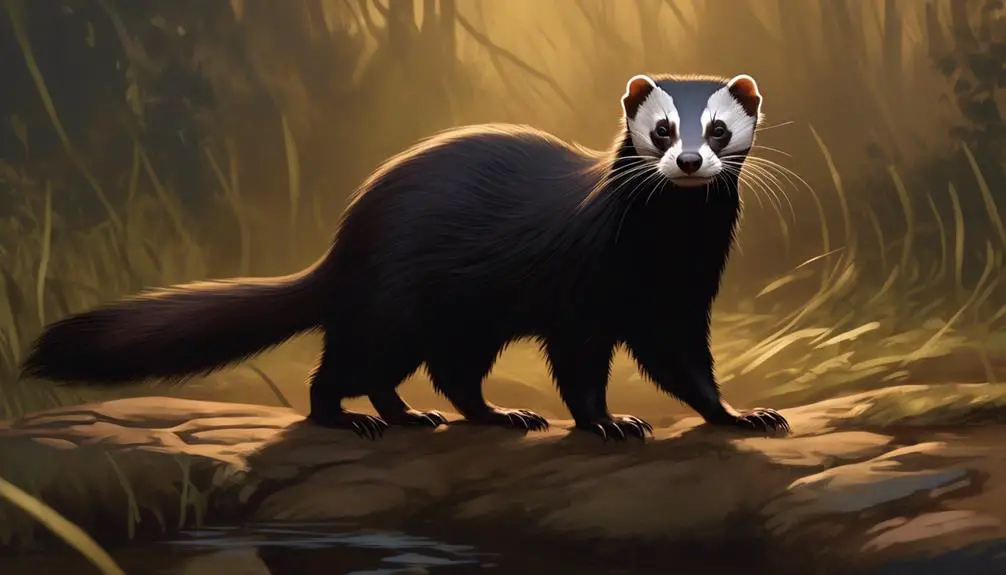
With its dark brown fur, pale underbelly, and distinct facial mask, the polecat (Mustela putorius) is a slender mammal found in Europe. Polecats belong to the Mustelidae family and are closely related to ferrets, weasels, and otters. They’ve a sleek and elongated body, measuring around 40 to 50 centimeters in length, with a long bushy tail that adds to their overall slender appearance.
Polecats are well-adapted for their habitat, which includes forests, grasslands, and wetlands throughout Europe. They’re skilled hunters and primarily feed on small mammals, birds, reptiles, and insects. Their slender body allows them to move swiftly and navigate through narrow spaces while hunting for prey.
Despite their name, polecats aren’t related to cats. They’ve a distinct scent gland located near their anus, which they use for territorial marking and communication. This gland emits a pungent odor, similar to that of a skunk, as a defense mechanism when threatened.
In recent years, the polecat population has faced challenges due to habitat loss and fragmentation. However, conservation efforts have been successful in stabilizing their numbers in some regions. Polecats play a vital role in maintaining the balance of their ecosystems by controlling rodent populations.

Erzsebet Frey (Eli Frey) is an ecologist and online entrepreneur with a Master of Science in Ecology from the University of Belgrade. Originally from Serbia, she has lived in Sri Lanka since 2017. Eli has worked internationally in countries like Oman, Brazil, Germany, and Sri Lanka. In 2018, she expanded into SEO and blogging, completing courses from UC Davis and Edinburgh. Eli has founded multiple websites focused on biology, ecology, environmental science, sustainable and simple living, and outdoor activities. She enjoys creating nature and simple living videos on YouTube and participates in speleology, diving, and hiking.

